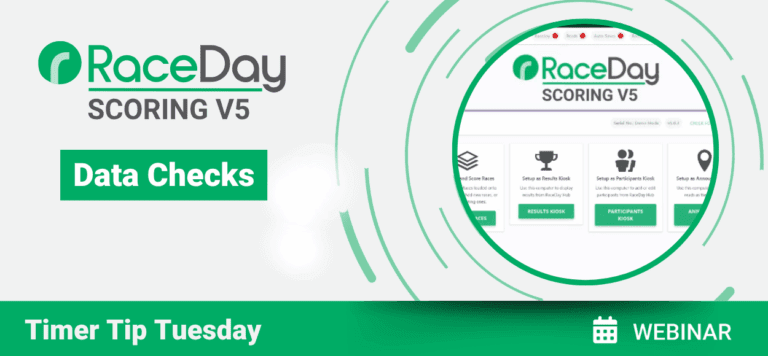Event Information
WHEN
ON DEMAND
Join us for this Timer Tip Tuesday session as we take a deeper dive into one of the most important components of successful race timing: data integrity. This week, we’ll focus on how to use RaceDay Scoring to identify and resolve common data issues before they affect your results.
In this practical how-to session, we’ll cover:
- Setting up your event for clean data from the start
- Best practices for importing and reviewing participant and team data
- How to spot red flags in bib assignments, divisions, and team configurations
- Real-time tools within RaceDay Scoring to detect and correct issues
- Tips for using Reports and Data Check Views for on-the-fly troubleshooting
- Examples of common data mistakes and how to handle them quickly on race day
Perfect for both new and experienced timers, this session will help you sharpen your skills in managing data confidently and efficiently within RaceDay Scoring.
Summary of Webinar
Overview
This session demystifies Data Checks and Data Actions in RaceDay Scoring—what they are, when to use each, and how to build reliable filters that catch issues early (or fix them automatically). You’ll see the default checks provided, how to import/export your own, practical filtering tips (participant and raw read filters), the new Edit History audit trail, and real examples—including cross country workflows that auto-place athletes into the correct varsity/JV events by time window.
What you’ll learn
Concepts & When to Use What
Data Actions: Fire automatically when conditions are met—best for deterministic, low-risk changes (e.g., set a flag when someone is seen in a window). Powerful but riskier if filters are wrong.
Data Checks: Build a list of matching participants for manual review (approve all/selected). Safer when the right outcome may vary case-by-case.
Built-in Defaults (ready to use)
Missing Gender • Missing Age • Missing Chip (if cross-reference loaded)
Suspicious Times (high age-grade threshold)
Missed Splits (uses the “missed segments” field)
Finishers Missing Start Read
Managing Your Library
Import/Export custom checks between races; renewals carry them forward automatically.
Filter Skills that Matter
Participant filters: registration & scoring fields (DNS/DNF, ages, event-specific splits).
Raw read filters: work on all chip reads (even unused)—use time windows, location, stream, occurrence, and
used = yesto narrow to scored reads.Operators you’ll actually use:
is null / is not null,contains,starts with, and handling multi-choice fields (remember “no response” ≠ “No”).
Practical Use Cases & Patterns
Wrong Start detection:
10K started at 8:00; 5K at 8:15 → find chip‐start difference > 15:00 (or raw reads in the 8:00–8:05 window) and move/DQ as policy dictates.
Split Too Short: missed segment + unused read at the segment location before min time → likely course short or min time needs tuning.
Announcer Safety Net: DNF = Yes and a late announcer read → quick list to investigate missed finishes.
Secondary Stream Check: flag finishers whose used read came from a secondary stream—helps spot hardware/channel issues.
Audit & Recovery
Edit History (Global & Per-Participant): See who/what changed, old vs. new values, and the source (data action, manual edit, API). Essential for rollback and trust.
Cross Country Automation
Use a “Holder” registration event for all athletes; create Data Actions that, upon a finish read within set time windows (and gender), move athletes into the correct Varsity/JV event automatically.
Tip: If you’re not 100% confident in windows/filters (AM/PM, dates, locations), start with Data Checks (manual) or have actions set custom fields first, then act from a review list.
Key Takeaways
Actions = auto, Checks = manual. When ambiguity exists, start with checks.
Build filters carefully—use time windows, location, occurrence, and
used = yeswhen you truly mean scored reads.Leverage defaults + tailor thresholds (trail vs. road, fast fields) for your races.
Edit History is your lifeline for auditing and undoing unintended changes.
Cross country: a holder → time-windowed move pattern is the cleanest way to place Varsity/JV as athletes are seen.
Helpful to-dos after watching
Turn on and review the default data checks before race day.
Create a few safe Data Actions that only set custom flags; combine with checks for controlled updates.
For XC, build and test holder + time-window logic well before the meet (verify AM/PM, dates, locations).
Practice with raw read filters on historical data so you’re confident in windows and occurrences.
